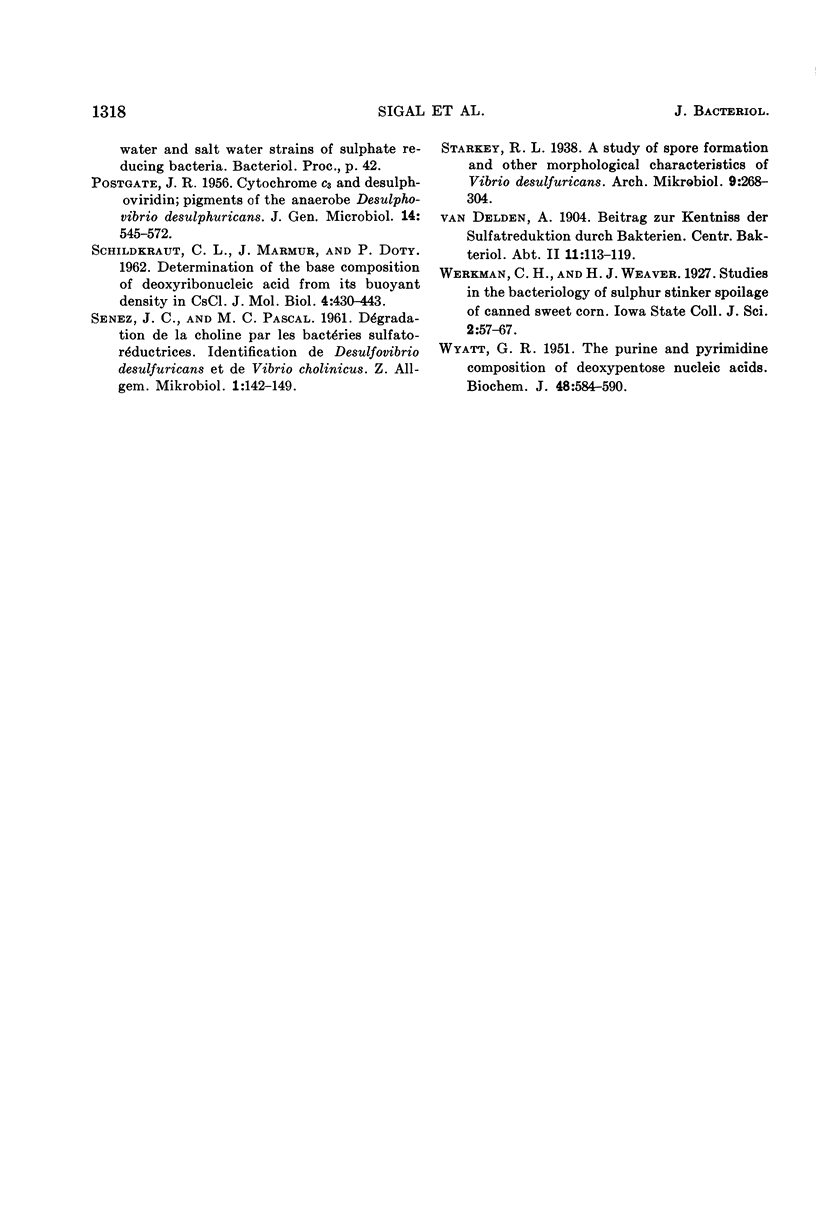Abstract
Sigal, Nicole (Laboratoire de Chimie Bactérienne du CNRS, Marseille, France), Jacques C. Senez, Jean Le Gall, and Madeleine Sebald. Base composition of the deoxyribonucleic acid of sulfate-reducing bacteria. J. Bacteriol. 85:1315–1318. 1963—The deoxyribonucleic acid constitution of several strains of sulfate-reducing bacteria has been analytically determined. The results of these studies show that this group of microorganisms includes at least four subgroups characterized by significantly different values of the adenine plus thymine to guanine plus cytosine ratio. The nonsporulated forms with polar flagellation, containing both cytochrome c3 and desulfoviridin, are divided into two subgroups. One includes the fresh-water, nonhalophilic strains with base ratio from 0.54 to 0.59, and the other includes the halophilic or halotolerant strains with base ratio from 0.74 to 0.77. The sporulated, peritrichous strains without cytochrome and desulfoviridin (“nigrificans” and “orientis”) are distinct from the above two types and differ from each other, having base ratios of 1.20 and 1.43, respectively.
Full text
PDF



Selected References
These references are in PubMed. This may not be the complete list of references from this article.
- ADAMS M. E., POSTGATE J. R. A new sulphate-reducing vibrio. J Gen Microbiol. 1959 Apr;20(2):252–257. doi: 10.1099/00221287-20-2-252. [DOI] [PubMed] [Google Scholar]
- CAMPBELL L. L., Jr, FRANK H. A., HALL E. R. Studies on thermophilic sulfate reducing bacteria. I. Identification of Sporovibrio desulfuricans as Clostridium nigrificans. J Bacteriol. 1957 Apr;73(4):516–521. doi: 10.1128/jb.73.4.516-521.1957. [DOI] [PMC free article] [PubMed] [Google Scholar]
- HAYWARD H. R., STADTMAN T. C. Anaerobic degradation of choline. I. Fermentation of choline by an anaerobic, cytochrome-producing bacterium, Vibrio cholinicus n. sp. J Bacteriol. 1959 Oct;78:557–561. doi: 10.1128/jb.78.4.557-561.1959. [DOI] [PMC free article] [PubMed] [Google Scholar]
- LE GALL J., SENEZ J. C., PICHINOTY F. Fixation de l'azote par les bactéries sulfato-réductrices; isolement et caractérisation de souches actives. Ann Inst Pasteur (Paris) 1959 Feb;96(2):223–230. [PubMed] [Google Scholar]
- MARSHAK A., VOGEL H. J. Microdetermination of purines and pyrimidines in biological materials. J Biol Chem. 1951 Apr;189(2):597–605. [PubMed] [Google Scholar]
- POSTGATE J. R. Cytochrome c3 and desulphoviridin; pigments of the anaerobe Desulphovibrio desulphuricans. J Gen Microbiol. 1956 Jul;14(3):545–572. doi: 10.1099/00221287-14-3-545. [DOI] [PubMed] [Google Scholar]
- SCHILDKRAUT C. L., MARMUR J., DOTY P. Determination of the base composition of deoxyribonucleic acid from its buoyant density in CsCl. J Mol Biol. 1962 Jun;4:430–443. doi: 10.1016/s0022-2836(62)80100-4. [DOI] [PubMed] [Google Scholar]
- WYATT G. R. The purine and pyrimidine composition of deoxypentose nucleic acids. Biochem J. 1951 May;48(5):584–590. doi: 10.1042/bj0480584. [DOI] [PMC free article] [PubMed] [Google Scholar]


